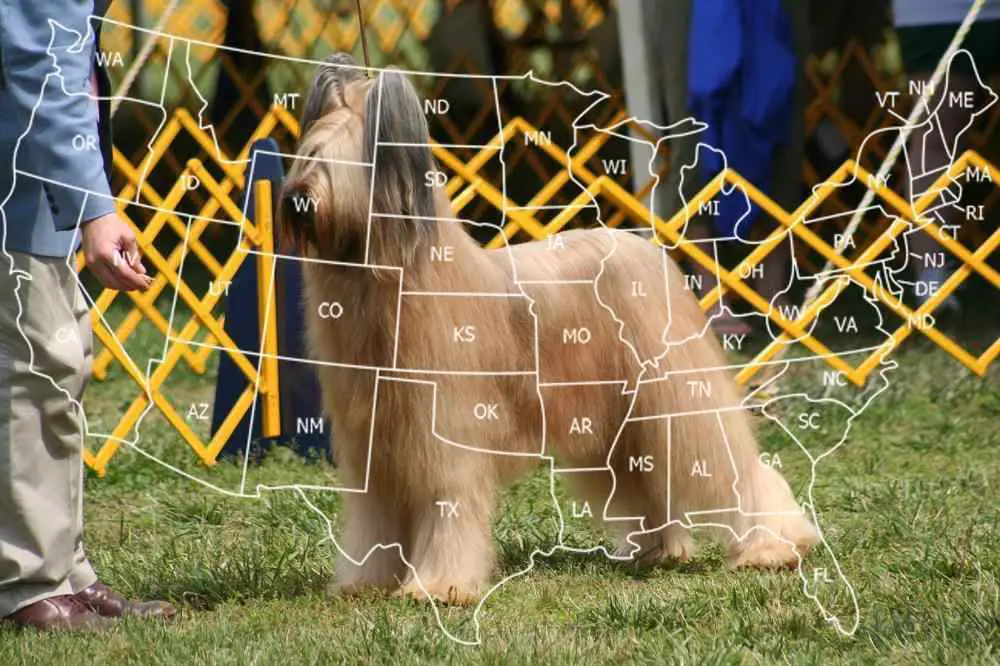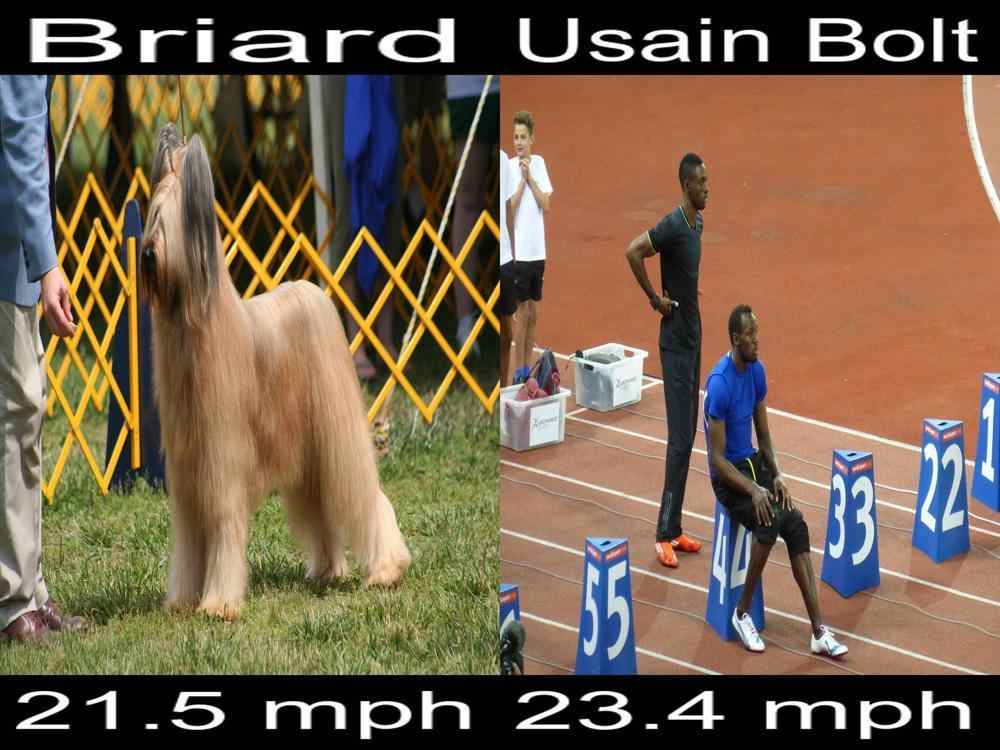Quick Links: Table of Contents
- Briard Breed Overview
- History of the Briard Breed. Where Briards came from
- What the Briard Looks Like
- How Much is the Briard Puppy?
- Best Briard Breeders
- Briard Growth
- Briard Litter Size
- How Fast Briards Can Run
- Good Names for Briards
- How Intelligent are Briards?
- How Popular are Briards with New Dog Owners?
- Health Problems in Briards and How to Prevent Them
- How to Take Care of Briard
- Dog Breeds That Are Similar to Briards
- Other Things to Know About Briards
Briard Breed Overview
The Briard is a large-sized dog.
The adult Briard stands 22 to 27 inches tall at the shoulder.
The Briard belongs to the Herding Dogs group.
Dogs in the Herding Dogs group, like the Briard, were bred for moving livestock, including sheep, cattle, and even reindeer.
Herding dogs work closely with their human shepherds, and their natural intelligence and responsiveness make them highly trainable.
Herding dogs have high levels of energy, which needs to be channeled properly to prevent destructive behavior.
Herding breeds are protective of their people and property and make excellent watchdogs. Their intelligence, agility, and activity level make them well suited to dog sports.
The fact that Briards belong to the Herding Dogs group is one of the reasons why Briards have the personality and temperament that they have.
The temperament of the Briard is generally described as:
- Faithful
- Fearless
- Intelligent
- Loyal
- Obedient
- Protective
History of the Briard Breed. Where Briards came from
The Briard can be traced back to the eighth century, when it was depicted in tapestries, and was mentioned in writings as early as the 12th century.
The Briard is an old French working dog that was thought to be descended from rough-coated sheepdogs.
The Briard was originally used to herd sheep and protect flocks from wolves and poachers.
The lands were divided into smaller sections as the French Revolution agitated the country.
Briards began to focus on herding the sheep within their smaller boundaries, as well as becoming the property`s guardians.
The breed was also used as a tracking, hunting, pack, and war dog, as well as to assist in the recovery of wounded soldiers left on the battlefield.
.
What the Briard Looks Like
The Briard is a large and unusual dog.
The powerful, burly square body moves with a gliding and smooth gait.
Long, sloping shoulders meet muscular forelegs and a powerful neck.
Another distinguishing feature is the tail, which is long and well-feathered, and ends in a J-shaped curve known as a crochet.
Oval feet have arched toes, thick pads, and strong nails.
There are two dewclaws on the hind legs.
Briards have a shaggy, long double coat.
The outer coat is long, wavy, and coarse, whereas the undercoat is fine and tight.
The Briard has a solid colored coat that comes in a variety of colors, the most common of which are black, gray, or tawny, but never white.
.
How Much is the Briard Puppy?

The average price of a Briard puppy is $2500. The price of a Briard puppy ranges from $2500 to $2500.
A lot of factors determine the price of the Briard. These factors include what health records the Briard puppy has, the lineage of the Briard puppy, the US state the breeder is located in, etc.
To estimate how much you can expect to pay for a puppy Briard based on the many factors that determine the price of the Briard puppy, check out our calculator that lets you estimate how much you should expect to pay for the Briard puppy based on what you want in the puppy.
When looking to buy a puppy, look at buying a puppy only from well-established breeders that breed puppies primarily for the love of the Briard breed, and secondarily for profit. Do not buy a puppy from a puppy mill. Puppy mills mass-produce puppies in bad living conditions for maximum profit.
You may also consider adopting instead of buying a puppy. Adoption costs are very low compared to the price of a puppy.
Best Briard Breeders

We have researched reputable Briard breeders that you can buy a puppy.
Go to this page for our complete list of reputable Briard breeders in various states in the United States.
On this page, you will see how much these breeders sell their puppies for, and how many puppies they have available.
A few of these breeders are listed below.
Bri`Annahs Briards
Puppy Price: $3000
Sagi Briards
Puppy Price: Check with breeder
Briardale
Puppy Price: Check with breeder
LAURIE SENTI
Puppy Price: Check with breeder
Holly Dundore
Puppy Price: Check with breeder
Briard Growth

New Briard owners need to know about the growth of their Briards. This will help them plan their living spaces accordingly.
Also, knowing the typical growth pattern of the Briard will help new owners catch the abnormal growth of their Briard early.
See our calculator for predicting how big your Briard puppy will get. You will also learn about the typical weight of the Briard at different ages and how to catch abnormal growth in your Briard

Briard Litter Size
Researchers from the Norwegian School of Veterinary Science did a study where they counted the numbers of puppies in 6 different Briard birth litters.
From this study, the researchers found that the average number of puppies that Briards can have is 7 puppies. Also, the Briard can have as few as 2 puppies per litter and as many as 13 puppies per litter.
The number of puppies that the Briard will have depends on factors such as the age of the Briard, the method of pregnancy, etc.
Click here to see our calculator for predicting how many puppies your Briard will have and how the litter size of the Briard compares to the litter size of other dog breeds.
How Fast Briards Can Run

How fast a dog breed can run is a good measure of how athletic the dog breed is.
The American Kennel Club (AKC) regularly conducts dog running competitions. The AKC records the running speed of competing dogs in these competitions. These competitions are open to all dog breeds.
Based on our analysis of the speeds of 28 different Briards, the average speed of the Briard is 21.5 mph (34.5 kmph).
The fastest speed on AKC record that the Briard ran in a race is 28.45 mph (45.8 kmph) and the minimum speed on record in a race for a Briard is 13.04 mph (21.0 kmph).
Click here to see how the speed of the Briard compares to the speed of other dogs and other mammals such as cats, horses, humans, etc.

Good Names for Briards
Here are some really good names that are typical for the Briard ranked by popularity:
- Bruno
How Intelligent are Briards?
| Briard | |
|---|---|
| Intelligence Rank | 30 out of 130 dog breeds |
| Trainability | Tend To Learn New Commands After 15 To 25 Repetitions |
According to Prof. Stanley Coren, a Canadian psychology professor/dog trainer, the total intelligence that a dog demonstrates is the addition of three types of intelligence. These intelligence types are:
- Instinctive Intelligence: This is the natural intelligence that comes from instinct. For example, dog breeds that have been historically bred to be guard dogs will have a high `guarding` intelligence compared to dogs that were not bred for guarding.
- Adaptive Intelligence (learning and problem-solving ability): This indicates what a dog can learn to do for himself or herself. Adaptive intelligence is specific to each dog, and not breed specific. You can improve your dog`s adaptive intelligence by investing time to train your dog.
- Working/Obedience Intelligence: This type of intelligence is breed-specific. Certain dog breeds tend to have higher working/obedience intelligence than some other breeds. This intelligence is the closest to what we might call school-learning ability and it is based upon what the dog can learn to do when instructed by humans. This type of intelligence can be measured for each dog breed and compared to that of other dog breeds.
Professor Stanley Coren measured and ranked the working intelligence of about 130 different dog breeds.
Prof. Coren found that the Briard has an obedience intelligence rank of 30 out of 130 dog breeds. Thus, Prof. Coren put Briards in the `Above Average Working Dogs` category.
This means that Briards tend to learn new commands after 15 to 25 repetitions.
However, we should mention that a dog should not be judged based on its intelligence alone. There are other important factors you need to consider when deciding on which dog breed to get. These other factors include sociability, adorability, and compatibility of the dog breed with your lifestyle.
See the intelligence ranking of some other dog breeds below:
| Breed | Intelligence Rank |
|---|---|
| Standard Poodle | 2 |
| German Shepherd Dog | 3 |
| Labrador Retriever | 7 |
| Pembroke Welsh Corgi | 11 |
| German Shorthaired Pointer | 17 |
| Belgian Malinois | 22 |
| Cardigan Welsh Corgi | 26 |
| Giant Schnauzer | 28 |
| Airedale Terrier | 29 |
| Samoyed | 33 |
| Cairn Terrier | 35 |
| Norwich Terrier | 38 |
| Dalmatian | 39 |
| Pug | 57 |
| Italian Greyhound | 60 |
| Great Pyrenees | 64 |
| Beagle | 72 |
| Bloodhound | 74 |
| Basenji | 78 |
| Afghan Hound | 79 |
How Popular are Briards with New Dog Owners?
Every year, the American Kennel Club (AKC) publishes information on how popular a dog breed is in that particular year. The AKC gets the popularity information of a breed from how many dogs of that breed the owners register with the AKC every year. The AKC collects this data for about 200 dog breeds.
The graph below shows the popularity trend of the Briard.
The popularity of the Briard averaged over the years is Number 135 out of about 200 dog breeds.

Do not get a dog breed just because it is a popular dog breed. And do not reject a dog breed just because it is an unpopular breed.
Health Problems in Briards and How to Prevent Them
Every dog breed has its own set of health problems that it tends to develop. There is nothing like a perfect dog breed.
The Briard is prone to certain genetic health conditions. The Orthopedic Foundation for Animals (OFA) is an organization that keeps track of genetic health problems in dog breeds.
From the extensive records that the OFA keeps, the OFA knows what health problems each dog breed is naturally prone to develop.
Hence, the OFA recommends which health screening breeders should perform on a dog breed to make sure that the breeders won`t breed `defective` dog parents that can pass down defective genes to their puppy offspring.
If you want a Briard puppy that will grow up to be healthy, make sure that your Briard breeder screens your puppy or your puppy`s parents for the health problems that the OFA recommends for your puppy`s breed. This will increase the chances that your puppy is free from genetic defects.
The following are the health tests that Orthopedic Foundation for Animals (OFA) recommends that breeders should screen Briards for:
- Autoimmune thyroiditis
- Elbow Dysplasia
- Eye Examination at least once between six (6) months and eight (8) years
- Hip Dysplasia (min age 24 months for all tests)
- Stationary Night Blindness
You can find out more about OFA`s recommended tests for Briards here.
How to Take Care of Briard
To take good care of your Briard, you need to make sure that you groom your Briard regularly.
Secondly, you need to find a veterinarian in your area that will routinely check the health status of your Briard regularly, and give you appropriate recommendations on your Briard`s preventative care.
Thirdly, you need to commit some time to exercise your Briard daily. Regular exercise helps improve the health and quality of life of your Briard.
Also, you need to feed your Briard high-quality dog food, and the food should be of the right amount to prevent your Briard from getting overweight or underweight.
See our recommendations on what to feed the Briard and how much food to feed the Briard at different life stages.
Finally, you need to make sure that your Briard has access to clean water all the time. See our recommendations on how much water your Briard needs to drink at different ages.
Dog Breeds That Are Similar to Briards
If you have not made up your mind on which dog breed to get, you may also want to consider some other dogs similar to the Briard.
We crunched the numbers and found that the following dog breeds that have similar behavior and temperament as the Briard:
- Barbet (77 percent match with Briard). Learn more about the Barbet here.
- Norwegian Buhund (76 percent match with Briard). Learn more about the Norwegian Buhund here.
- Polish Lowland Sheepdog (77 percent match with Briard). Learn more about the Polish Lowland Sheepdog here.
- Puli (77 percent match with Briard). Learn more about the Puli here.
- Pyredoodle (78 percent match with Briard). Learn more about the Pyredoodle here.
Other Things to Know About Briards
Here are some of the very important characteristics of the Briard that you need to know about the Briard breed:


